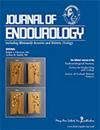求助PDF
{"title":"<i>In Vitro</i> Comparison of Pulsed-Thulium:YAG, Holmium:YAG, and Thulium Fiber Laser.","authors":"Marie Chicaud, Stessy Kutchukian, Laurent Berthe, Mariela Corrales, Catalina Solano, Luigi Candela, Steeve Doizi, Daron Smith, Olivier Traxer, Frédéric Panthier","doi":"10.1089/end.2024.0424","DOIUrl":null,"url":null,"abstract":"<p><p><b><i>Objective:</i></b> To characterize the pulse characteristics and risk of fiber fracture (ROF) of the pulsed-Thulium:YAG (p-Tm:YAG) laser and to compare its ablation volumes (AVs) against Holmium:Yttrium-Aluminium-Garnet (Ho:YAG) laser and Thulium fiber laser (TFL). <b><i>Materials and Methods:</i></b> p-Tm:YAG (100 W-Thulio, Dornier-Medtech<sup>©</sup>, Germany) was characterized using single-use 272 μm core-diameter-fibers. p-Tm:YAG characterization included pulse shape, duration, and peak power (PP) studies. ROF was assessed after 5 minutes of continuous laser activation (CLA) at five decreasing fiber bend radii (1, 0.9, 0.75, 0.6, and 0.45 cm). p-Tm:YAG, Ho:YAG (120 W-Cyber-Ho, Quanta<sup>®</sup>, USA), and TFL (60 W-TFLDrive, Coloplast<sup>®</sup>, Denmark) AVs were compared using a 20-mm linear CLA at 2 mm/second velocity in contact with 20 mm<sup>3</sup> hard stone phantoms (HSP) and soft stone phantoms (SSP) (15:3 and 15:5 water to powder ratio, respectively) fully submerged in saline at 0.5 J-20 Hz or 1 J-10 Hz. After CLA, phantoms underwent three-dimensional (3D) micro-scanning (CT) and subsequent 3D segmentation to estimate the AVs, using 3DSlicer<sup>©</sup>. Each experiment was performed in triplicate. <b><i>Results:</i></b> p-Tm:YAG presents a uniform pulse profile in all of the available preset modes. PP ranged from 564 to 2199 W depending on pulse mode. No laser fiber fracture occurred at any bend radius. p-Tm:YAG achieved similar mean AVs to TFL and Ho:YAG for HSP (8.96 ± 3.1 <i>vs</i> 9.78 ± 1.1 <i>vs</i> 8.8 ± 2.8 mm<sup>3</sup>, <i>p</i> = 0.67) but TFL was associated with higher AVs compared with p-Tm:YAG and Ho:YAG (12.86 ± 1.85 <i>vs</i> 10.12 ± 1.89 <i>vs</i> 7.56 ± 2.21 mm<sup>3</sup>, <i>p</i> = 0.002) against SSP. AVs for HSP increased with pulse energy for p-Tm:YAG and Ho:YAG and (11.56 ± 1.8 <i>vs</i> 6.36 ± 0.84 mm<sup>3</sup> and 11.27 ± 1.98 <i>vs</i> 6.34 ± 0.55 mm<sup>3</sup>, <i>p</i> = 0.03 and <i>p</i> = 0.02), whereas AVs for SSP were similar across laser settings for all laser sources. AVs with TFL were similar across laser settings for both phantom types. <b><i>Conclusion:</i></b> p-Tm:YAG combines intermediate PP between Ho:YAG and TFL, a uniform pulse profile, no ROF with increasing deflection and effective ablation rates. Further clinical studies are needed to confirm these <i>in vitro</i> results.</p>","PeriodicalId":15723,"journal":{"name":"Journal of endourology","volume":" ","pages":"1427-1435"},"PeriodicalIF":2.9000,"publicationDate":"2024-12-01","publicationTypes":"Journal Article","fieldsOfStudy":null,"isOpenAccess":false,"openAccessPdf":"","citationCount":"0","resultStr":null,"platform":"Semanticscholar","paperid":null,"PeriodicalName":"Journal of endourology","FirstCategoryId":"3","ListUrlMain":"https://doi.org/10.1089/end.2024.0424","RegionNum":2,"RegionCategory":"医学","ArticlePicture":[],"TitleCN":null,"AbstractTextCN":null,"PMCID":null,"EPubDate":"2024/10/1 0:00:00","PubModel":"Epub","JCR":"Q1","JCRName":"UROLOGY & NEPHROLOGY","Score":null,"Total":0}
引用次数: 0
引用
批量引用
Abstract
Objective: Materials and Methods: © , Germany) was characterized using single-use 272 μm core-diameter-fibers. p-Tm:YAG characterization included pulse shape, duration, and peak power (PP) studies. ROF was assessed after 5 minutes of continuous laser activation (CLA) at five decreasing fiber bend radii (1, 0.9, 0.75, 0.6, and 0.45 cm). p-Tm:YAG, Ho:YAG (120 W-Cyber-Ho, Quanta® , USA), and TFL (60 W-TFLDrive, Coloplast® , Denmark) AVs were compared using a 20-mm linear CLA at 2 mm/second velocity in contact with 20 mm3 hard stone phantoms (HSP) and soft stone phantoms (SSP) (15:3 and 15:5 water to powder ratio, respectively) fully submerged in saline at 0.5 J-20 Hz or 1 J-10 Hz. After CLA, phantoms underwent three-dimensional (3D) micro-scanning (CT) and subsequent 3D segmentation to estimate the AVs, using 3DSlicer© . Each experiment was performed in triplicate. Results: vs 9.78 ± 1.1 vs 8.8 ± 2.8 mm3 , p = 0.67) but TFL was associated with higher AVs compared with p-Tm:YAG and Ho:YAG (12.86 ± 1.85 vs 10.12 ± 1.89 vs 7.56 ± 2.21 mm3 , p = 0.002) against SSP. AVs for HSP increased with pulse energy for p-Tm:YAG and Ho:YAG and (11.56 ± 1.8 vs 6.36 ± 0.84 mm3 and 11.27 ± 1.98 vs 6.34 ± 0.55 mm3 , p = 0.03 and p = 0.02), whereas AVs for SSP were similar across laser settings for all laser sources. AVs with TFL were similar across laser settings for both phantom types. Conclusion: in vitro results.
脉冲铥:YAG 激光、钬:YAG 激光和铥光纤激光的体外比较。
目的描述脉冲铥:YAG(p-Tm:YAG)激光器的脉冲特性和光纤断裂风险(ROF),并将其烧蚀体积(AV)与钬:YAG(Ho:YAG)和铥光纤激光器(TFL)进行比较。材料和方法:p-Tm:YAG(100W-Thulio,DornierMedtech©,德国)使用一次性使用的 272μm 芯径光纤(CDF)进行表征。在 5 分钟连续激光激活(CLA)后,在五个递减光纤弯曲半径(1、0.9、0.75、0.6 和 0.45 厘米)下对 ROF 进行了评估。比较了 p-Tm:YAG、Ho:YAG(120W-Cyber-Ho,Quanta®,美国)和 TFL(60W-TFLDrive(Coloplast®, 丹麦))AV,使用的是 20 毫米线性 CLA,速度为 2 毫米/秒,与完全浸没在生理盐水中的 20 毫米立方体硬石和软石模型(HSP 和 SSP,水粉比为 15:3 和 15:5)接触,频率为 0.5J-20Hz 或 1J-10Hz。CLA后,使用3DSlicer©对假体进行三维(3D)显微扫描(计算机断层扫描)和随后的三维分割,以估算AV。结果:在所有可用的预设模式中,p-Tm:YAG 呈现出均匀的脉冲曲线。根据脉冲模式的不同,峰值功率(PP)在 564 到 2199W 之间。对于 HSP(8.96±3.1 vs 9.78±1.1 vs 8.8±2.8mm3,p=0.67),p-Tm:YAG 与 TFL 和 Ho:YAG 获得了相似的平均 AVs(12.86±1.85 vs 10.12±1.89 vs 7.56±2.21mm3,p=0.002),但对于 SSP,TFL 与 p-Tm:YAG 和 Ho:YAG 相比具有更高的 AVs(12.86±1.85 vs 10.12±1.89 vs 7.56±2.21mm3,p=0.002)。随着脉冲能量的增加,p-Tm:YAG 和 Ho:YAG 的 HSP AVs 增加(11.56±1.8 vs 6.36±0.84 mm3 和 11.27±1.98 vs 6.34±0.55mm3,p=0,03 和 p=0,02),而所有激光源在不同激光设置下的 SSP AVs 相似。结论:p-Tm:YAG 具有介于 Ho:YAG 和 TFL 之间的峰值功率、均匀的脉冲轮廓、随着偏转的增加不会出现纤维断裂的风险以及有效的消融率。需要进一步的临床研究来证实这些体外结果。
本文章由计算机程序翻译,如有差异,请以英文原文为准。


